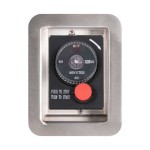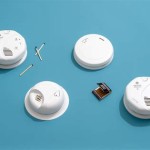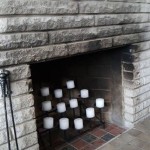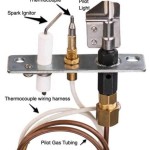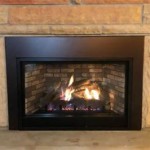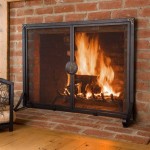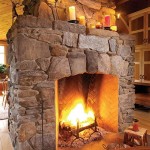Fireplace Hearth Pads: Essential Safety for Babies
Ensuring the safety of a baby within a home environment requires vigilant attention to potential hazards. Fireplaces, while aesthetically pleasing and functional for heating, present considerable risks to infants and toddlers. The hearth, typically constructed from stone, brick, or tile, poses a significant risk of injury due to its hard, sharp edges and potential for radiating heat. Therefore, the implementation of appropriate safety measures, specifically the installation of fireplace hearth pads, is crucial for creating a safe space for babies.
Fireplace hearth pads serve as protective barriers, mitigating the risks associated with direct contact with the hearth. These pads are typically constructed from materials that offer impact absorption and thermal resistance, reducing the severity of injuries from falls or accidental contact with a hot surface. The selection of an appropriate hearth pad requires careful consideration of factors such as size, material, and attachment method. This article delves into the essential aspects of fireplace hearth pads for baby safety, providing comprehensive information for parents and caregivers to make informed decisions.
Understanding the Risks Associated with Fireplace Hearths
The inherent design and functionality of a fireplace hearth contribute to several specific safety hazards for babies. The hard surfaces of brick, stone, or tile are primary concerns, as falls onto these surfaces can result in head injuries, contusions, and fractures. Babies, with their developing motor skills and inherent curiosity, are prone to exploring their surroundings, often without a full understanding of potential dangers. This exploratory behavior significantly increases the risk of accidental falls and impacts against the hearth.
Furthermore, even when a fire is not actively burning, the hearth can retain residual heat for a considerable period of time. This residual heat can cause burns to a baby's sensitive skin upon contact. The lack of awareness of heat sources and the tendency to touch or explore objects within reach make babies particularly vulnerable to burn injuries from the hearth. The combination of hard surfaces and potential for retained heat necessitates the implementation of effective safety measures, such as fireplace hearth pads, to mitigate these risks.
The sharp edges and corners commonly found on hearths also present a laceration hazard. A baby crawling or toddling near a fireplace hearth could easily scrape against these edges, resulting in cuts and abrasions. These lacerations, while often minor, can be painful and require prompt attention to prevent infection. The design of a fireplace hearth, intended for aesthetic appeal and functionality, often overlooks the potential safety implications for young children. Therefore, the proactive installation of a hearth pad, specifically designed to address these hazards, is a critical step in ensuring a safe environment.
Key Features of Effective Fireplace Hearth Pads
Selecting the right fireplace hearth pad involves evaluating several key features to ensure optimal safety and functionality. Material selection is paramount, with options ranging from foam and rubber to specialized heat-resistant fabrics. Foam pads offer excellent impact absorption, cushioning falls and minimizing the risk of injury. Rubber pads provide a durable and slip-resistant surface, reducing the likelihood of falls in the first place. Heat-resistant fabrics, often used in conjunction with a cushioning layer, offer protection against burns from residual heat.
The size and shape of the hearth pad should be carefully considered to ensure adequate coverage of the hazardous area. The pad should extend beyond the edges of the hearth, creating a buffer zone that minimizes the risk of contact with the hard surfaces. Custom-shaped pads may be necessary for irregularly shaped hearths to provide complete coverage. The dimensions of the pad should be carefully measured and selected based on the specific configuration of the fireplace hearth.
The method of attachment is another crucial aspect to consider. Hearth pads can be attached using adhesive, hook-and-loop fasteners, or custom-fitted frames. Adhesive provides a secure and permanent attachment, preventing the pad from shifting or being easily removed by a child. Hook-and-loop fasteners offer a removable option, allowing for occasional cleaning or repositioning. Custom-fitted frames provide a secure and aesthetically pleasing solution, particularly for larger or more complex hearth designs. The chosen attachment method should be secure, reliable, and appropriate for the specific type of hearth and the surrounding environment.
Beyond the essential safety features, the aesthetic appeal of the hearth pad should also be taken into account. Hearth pads are available in a variety of colors and styles to complement the existing décor of the room. Choosing a pad that blends seamlessly with the surrounding environment can help to maintain the aesthetic appeal of the fireplace while providing essential safety for the baby. Balancing safety and aesthetics is an important consideration in the selection process.
Durability is also an essential factor. The hearth pad will endure regular use and potential abuse from a baby's activity. Selecting a hearth pad constructed from high-quality, durable materials will ensure that it provides long-lasting protection and maintains its integrity over time. A durable hearth pad will resist tearing, abrasion, and compression, providing consistent protection against falls and impacts.
Installation and Maintenance of Fireplace Hearth Pads
Proper installation is crucial to maximizing the effectiveness of a fireplace hearth pad. Before installation, the hearth surface should be thoroughly cleaned to remove any dirt, dust, or debris that could interfere with adhesion. The manufacturer's instructions should be carefully followed to ensure proper attachment of the pad. For adhesive-backed pads, the adhesive should be applied evenly and firmly pressed onto the hearth surface. For hook-and-loop fasteners, the corresponding strips should be securely attached to both the hearth and the pad. For custom-fitted frames, the frame should be properly aligned and secured to the hearth using appropriate hardware.
Regular maintenance is essential to ensure the continued effectiveness and longevity of the hearth pad. The pad should be regularly inspected for any signs of wear, tear, or damage. Any damaged areas should be promptly repaired or replaced to maintain the integrity of the protective barrier. The pad should also be regularly cleaned to remove any dirt, spills, or stains. Cleaning instructions will vary depending on the material of the pad, but generally, a mild soap and water solution can be used for cleaning. Harsh chemicals or abrasive cleaners should be avoided, as they can damage the pad's surface.
The hearth pad should be periodically checked for secure attachment. Over time, adhesive or fasteners may loosen, compromising the pad's stability. If any loosening is detected, the attachment should be reinforced or replaced. The security of the attachment is critical to prevent the pad from shifting or being removed by a child, which could expose the hazardous hearth surface.
In addition to regular cleaning and inspection, it is important to be mindful of the potential for heat damage. While heat-resistant pads offer protection against residual heat, prolonged exposure to high temperatures can still cause damage. Avoid placing hot objects directly on the hearth pad and ensure that the fireplace is properly ventilated to prevent excessive heat buildup. By following these installation and maintenance guidelines, parents and caregivers can ensure that the fireplace hearth pad provides long-lasting and effective protection for their baby.
Furthermore, consider the long-term use of the hearth pad. As the child grows and becomes more mobile, the need for the pad may diminish. However, it's still prudent to keep the pad in place until the child is old enough to understand the dangers associated with the fireplace and hearth. Removing the pad prematurely could expose the child to unnecessary risks.
The selection and installation of a fireplace hearth pad represent a significant investment in the safety and well-being of a baby. By understanding the risks associated with fireplace hearths, selecting a pad with appropriate features, and following proper installation and maintenance guidelines, parents and caregivers can create a safe and comfortable environment for their child to explore and grow.

Jack Mat Hearth Safety Seat The And Home

Baby Proofing Fireplace More Easy Hearth Padding Oh Love Proof House

Terrific Photos Diy Fireplace Hearth Concepts A Is Usually The Important Part Of Fire Ex Baby Proof

Cardinal Gates Fireplace Cushion Hearth Pads Brown Spk Br C The Home Depot

Baby Proof The Fireplace Hearth With A Padded Bench Fosterpabedrooms Childproof Cover

Jack Mat Hearth Safety Seat The And Home

Babysafetyfoam Com Baby Proofing Fireplace Hearth Guard Bumper Pad Safety Cushion Cover Protection

Fireplace Hearth Seat Cushion Jack Mat

How To Baby Proof A Fireplace Diy Hearth Cushion Simply September

How To Baby Proof A Fireplace Diy Hearth Cushion Simply September
Related Posts

